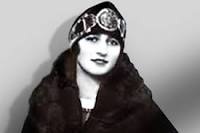
Biography.
María Calvo Nodarse, "La Macorina", was a Cuban woman born approximately in 1892 in Guanajay town, then Pinar del Río province. Her real name was María Constancia Caraza Valdés. Not much information is known from her childhood, it is only known that at exactly the age of 15 she ran away from home and moved to Havana accompanied by her boyfriend and only love; but the economic hardships made her abandon her romance and enter the world of prostitution.
The birth of "La Macorina"
The audacity and beauty this woman enjoyed made her enter the most selected circles of Cuban society at the time. It is said her attractive personality and beautiful eyes, help her to be one of the most elegant and famous prostitutes of the time. She was neither a prostitute in the indiscriminate sense that this profession entails, nor worked in a brothel, but selectively prostituted herself. In this way, she began her fast career towards opulence, according to an interview Guillermo Villarronda made her for the Bohemia magazine on October 26th, 1958: "More than a dozen men remained at my feet, drowned in money, supplicants for love “. She was the friend of wealthy Havana people dedicated to politics and business, including José Miguel Gómez (popularly known as "Tiburon"), whom she helped with her loyalty during the events of 'La Chambelona'.
Regarding the origin of her nickname "La Macorina", it is said that on one occasion, while María was walking on the sidewalk of the Louvre, a young man who had drunk more than he should said, as the beautiful woman passed by: “There goes La Macorina !”, when actually meant La Fornarina, one of the most representative works of the Italian Renaissance painter Rafael Sanzio (1483-1520). For its realization, the Roman model and lover of the artist Margherita Luti posed (c. 1493-1522), daughter of the baker (in Italian, fornaio) Francesco Luti di Siena, who already appears in other compositions by the author, especially between 1510 and 1517.
Her decline and death.
After accumulating wealth and being part of the most selective social circles in Havana, the national economic situation was no longer so prosperous, but perhaps the indisputable fact was that Macorina was then 42 years old.
Friends from the past were using excuses every time she asked them for help, and so she was selling all her belongings, from jewelry to houses and cars: La Macorina ended up in a very absolute poverty, living in a rented room in a Havana family home. La Macorina began to lose youth and popularity inexorably. She had to sell her nine cars, her four mansions, her dresses, jewelry, furs, everything, and died almost in misery. Classified by some as the Cuban Mata Hari. It is known that the Macorina, in addition to being the first woman to obtain a license and drive a car, had a dissipated life, which in her old years she repented. She passed away in Havana.
Legend Character.
Macorina was so popular that not only has two musical compositions and a painting by CundoBermúdez in her honor, but was also immortalized in the Bejucal’s famous brass bands, which are held in December and where, in a character's parade, appeared a doll with a mask under which was its creator, a bricklayer named Lorenzo Romero Miñoso. The Asturian Alfonso Camín wrote his famous poem "Macorina" (included in his book "Carey") that the Costa Rican naturalized Mexican singer Chavela Vargas transformed into one of the best-known songs of her career.





Read more...